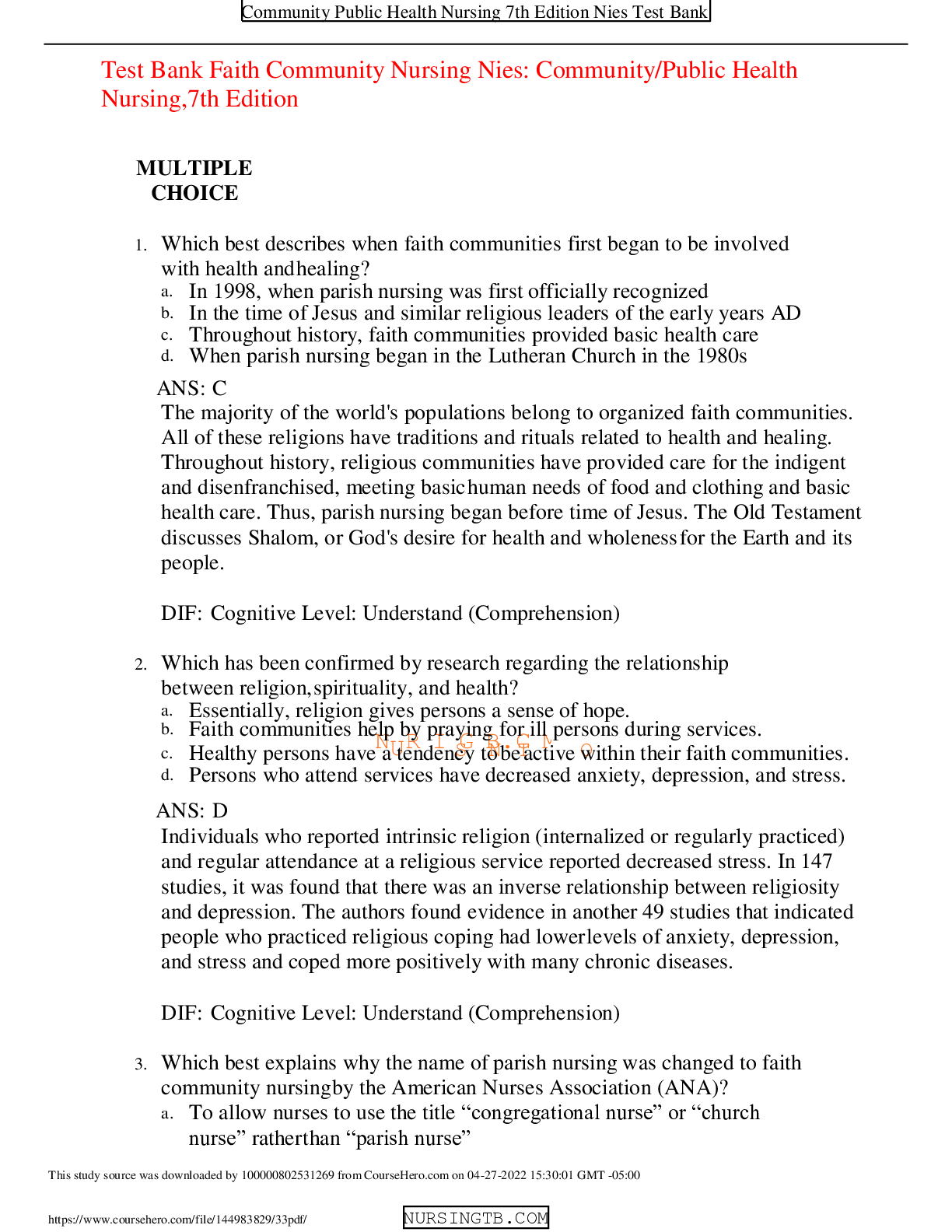*NURSING > TEST BANK > Test Bank Men’s Health Nies: Community/Public Health Nursing, 7th Edition,100% CORRECT (All)
Test Bank Men’s Health Nies: Community/Public Health Nursing, 7th Edition,100% CORRECT
Document Content and Description Below
Test Bank Men’s Health Nies: Community/Public Health Nursing, 7th Edition MULTIPLE CHOICE 1. A male client reports that he is unable to change his health behaviors and adopt a healthier life... style. Which is the most likely reason for his difficulty? a. Lack of financial resources b. Lack of transportation c. Lack of programs d. Lack of motivation ANS: D Two nurse researchers (Dallas & Neville, 2012) conducted a study to describe the health education and health screening practices of older men living in an area of New Zealand and the perceived barriers and benefits of healthy lifestyle choices. Of those men who did report barriers, the most common reason was lack of motivation (12%), followed by lack of knowledge related to availability of programs and screenings (8%). Reported external barriers included: lack of programs, associated costs, and transportation challenges. DIF: Cognitive Level: Apply (Application) 2. Which gender perceives and reports having better health? a. Females b. Males c. No difference between genders in perceived health status d. Perceived health status variUes sStronNglyTby indiOviduals more than gender ANS: B Despite the differences in mortality rates, men tend to perceive themselves to be in better health than women. In the National Health Interview Survey, which asked people to rate their health status, men were more likely to rate their health as excellent or very good as opposed to fair or poor. DIF: Cognitive Level: Remember (Knowledge) 3. Which gender has higher morbidity rates with a higher prevalence of chronic diseases that cause disability and limitation of activities? a. Females b. Males c. No difference between genders in chronic health problems d. Prevalence of chronic diseases varies strongly by individuals more than gender ANS: A A chronic condition is a condition that persists for at least 3 months or belongs to a group of conditions classified as chronic regardless of time of onset. In general, women have higher morbidity rates than men. Women are more likely than men to have a higher prevalence of chronic diseases that cause disability and limitation of activities but do not lead to death. DIF: Cognitive Level: Remember (Knowledge) 4. Which statement best explains why men are sicker on hospital admission than women? a. Men do not have access to care. b. Men do not seek treatment until they are very ill. c. Men have chronic conditions more than women. d. Men have more acute illnesses than women. ANS: B Males continue to delay medical treatment, resulting in men being sicker when they do seek health care. Because they are sicker, they require more intensive medical care. The main reason that they are sicker does not relate to the increased or decreased incidence of acute or chronic illness or lack of access to care, the delayed time in seeking treatment is what results in them being sicker at the time of hospital admission. DIF: Cognitive Level: Understand (Comprehension) 5. Which statement is correct? a. Males are more likely to have colorectal testing than females. b. Males are more likely to receive dental care than females. c. Males are more likely to have routine physicals than females. d. Males are more likely to be eligible for primary care services than females. ANS: D Men do not engage in these health protective behaviors at the same frequency as females (Brown and Bond, 2008). Most men do not have routine checkups. National health surveys indicate that women overall are more likely than men to have visits to various health care providers (NCHS, 2016). Men are twice as likely to report no usual source of care although eligibility for primary care inNmUaRleSs IexNceGeTdsBth.aCt fOoMr females (Lynch, 2008). Men tend to have fewer dental health care visits (64.1) versus women (68.9) (NCHS, 2016). Additionally, men have lower rates of use of colorectal testing and procedures (men, 56.7, women, 58.9) (NCHS, 2011, p. 303). DIF: Cognitive Level: Understand (Comprehension) 6. Which is a biological explanation for gender differences in health status? a. Influence of hormones b. Different treatment by parents c. Random differences in genetic inheritance d. Social expectations of appropriate gender behavior ANS: A Random differences are random and do not have a systematic effect. Although parents do indeed treat male and female babies differently, that is an environmental effect, not a biological one. Similarly, social expectations are a sociological explanation, not a biological one. Several biological factors influence sex differences in mortality and morbidity rates, including genetics, effects of sex hormones, and physiological differences. Biological advantages for females may also exist later in life because estrogen protects against heart disease. Some evidence supports the hypothesis that men’s higher testosterone levels contribute to men’s lower high-density lipoprotein levels. DIF: Cognitive Level: Understand (Comprehension) 7. Which is most effective in helping males choose healthier lifestyle behaviors? a. Educational programs that include both threat and reward b. Involvement in team sports at school or at work c. Physician prescription for a specific behavior change d. Support from a female family member concerned about the man’s well-being ANS: D Cheatham reported that several studies showed males to be more likely to change health behaviors when these changes were suggested and supported by female family members whom they believed were concerned about the well-being of the man. Thus, female support is more important than educational programming, being part of a team, or a physician prescription. DIF: Cognitive Level: Understand (Comprehension) 8. Based on theory, which is men most likely to do when they become ill? a. Ask their female partner what action might be helpful b. Ignore symptoms or refuse to see them as symptoms of illness and act tough c. See their physician as soon as possible d. Talk to other men about what would be the best action ANS: B Boys are socialized to ignore symptoms and “toughen up.” Men may be aware of being ill, but they make a conscious decision not to seek health care to avoid being labeled as “sick.” Brown and Bond suggest that men lack somatic awareness and are less likely to interpret symptoms as indicators of illness. Because of this ignorance and lack of recognition that a problem exists, they are not lNikUelRy StoIaNskGoTthBer.sCwOhaMt action to take or to see a physician for the problem. DIF: Cognitive Level: Understand (Comprehension) 9. Why do some researchers believe data regarding health behaviors may be inaccurate in relation to men? a. Men are not socialized to tell the truth when interviewed. b. Men do not know when they are ill. c. Most of the data are collected about and from women. d. Most of the data are collected by women. ANS: C Males are less likely than females to participate in the data collection process. Women are often solicited in health surveys to report the health behavior of men. As proxies, they have a tendency to underreport behavior. Men may not want to participate and will make light of health problems. Males may conceal or suppress pain in an effort to appear strong. Men believe that they are telling the truth, as they may be less willing to talk, may not recall health problems, and may lack a health vocabulary. There is nothing to suggest that the data are collected by women and that this causes a problem with inaccuracies. DIF: Cognitive Level: Understand (Comprehension) 10. Which action would improve a man’s probability of obtaining health screenings and health-promoting education? a. Being active in organized sports b. Joining the military c. Seeking an andrology specialist physician d. Working for an employer that requires employees to have an annual physical examination ANS: B The medical specialty of andrology is considered too narrow. Many private insurance companies will reimburse for illness but not preventive care, such as education or health promotion activities. Men are socialized to view health as a resource that enables the body to work. Therefore good health practices and preventive care are sometimes available in large industries or organized sports (sports medicine). The most complete care is currently offered by the military. DIF: Cognitive Level: Understand (Comprehension) 11. Which single action has been most influential in changing men’s health behaviors? a. Establishing well-man clinics during evening hours b. Legislative action c. Peer-reviewed journals such as the American Journal of Men’s Health d. Running men’s health ads during sports events e. The male consumer movement: seen in The National Organization for Changing Men ANS: B Health behaviors associated wNiUthRtSheIgNreGatTesBt .chCanOgMe in a positive direction have been those influenced by legislative action (e.g., seat belt use, use of smoke detectors, and drunk driving laws). Well clinics, peer-reviewed journals, and the male consumer movement have not had as much influence on men’s health behavior as legislative action. DIF: Cognitive Level: Remember (Knowledge) 12. A man has been off work because of a recent illness. Which would be the most useful action for the employer to take to support this man? a. Encourage the man to return to work as soon as possible, possibly at something less physically demanding b. Reassure the man that he may have as much time off as he needs c. Share the man’s need with other employees so that they may donate unused or unneeded sick time to him d. Suggest that other male employees visit the man at his home to help keep his spirits up and demonstrate he is not forgotten ANS: A Time away from work because of occupational injuries should be kept to a minimum. Males should be encouraged to return to work in an altered capacity rather than remaining away from work until the injury is completely healed. Employment keeps the man active during the day and also gives opportunity for socialization. Because the man should be encouraged to return to work, it would not be appropriate to request additional sick time from other employees or suggest that other employees visit him at home. DIF: Cognitive Level: Apply (Application) 13. Which question would be a good opening to address health concerns with a male client? a. “How do you know when you are ill?” b. “What sort of health problems or illnesses do you have?” c. “What are your usual physical activities?” d. “What would your wife say about your health?” ANS: C The text suggests to ask a man about how he spends his leisure time, what he is doing to take care of himself, and what his usual physical activities are. Thus, asking about his physical activities would be the most appropriate question. Asking how he knows when he is ill, the sorts of illnesses he experiences, or what his wife says about his health would not be a good opening to the conversation. DIF: Cognitive Level: Apply (Application) MULTIPLE RESPONSE 1. Which advantages do women have in relation to health screenings? (Select all that apply.) a. As the weaker sex, women are expected to be ill and see physicians more often. b. Employers often require health screening of their employees. c. Health care departments focus on maternal and child health. d. Women enjoy socialization during visits to health care providers. e. Women have more health screenings because of the need for birth control or physician visits related toNchiRldbeIarinGg. B.C M f. Women have more leisure time and can more easily see their health care providers. ANS: C, E Maternal and child health is a major focus of many health departments, and there is not a medical or nursing specialty within a health department that routinely exists to specifically address men’s health. Routine reproductive health screening has been expanded to include some general screening, such as testing blood pressure and urine and blood for chronic problems. Men do not have routine reproductive health checkups that include screening, which would detect other health problems at an early stage. Women see physicians more often because of the need for physicians related to childbearing, not because they enjoy the socialization with health care providers or have more time to complete these visits. Employers may require health screening of their employees, both male and female. Women enjoy socialization during visits to health care providers. DIF: Cognitive Level: Remember (Knowledge) 2. Which strategies would be most helpful to implement with adolescent males at a high school? (Select all that apply.) a. A short required course on how to be a good parent b. Assistance in learning how to control emotions and behaviors c. Classes in male physiology, self-screenings, and influence of nutrition and exercise d. Encouragement to be involved in organized team sports involving both genders e. Recognition of reality factors such as the need to be employed after school hours f. Interpersonal communication with a male school nurse ANS: A, C, F Some suggestions that may improve male health are information about how their bodies function, what is normal, what is abnormal, what action to take, and the contributions of proper nutrition and exercise; self-care instruction, including testicular and genital self-examination; help with fathering; and recognition that feelings of confusion and uncertainty in a time of rapid social change are normal and that they may mark the onset of healthy adaptation to change. Male nurses can be extremely effective in such an endeavor. Providing assistance in learning how to control emotions and behaviors, encouraging the involvement in organized team sports, and the recognition of reality factors would not be the most important strategies to implement with adolescent males? DIF: Cognitive Level: Understand (Comprehension) 3. Which strategies would most likely increase attendance at a clinic aiming to improve men’s health in the community? (Select all that apply.) a. Employing male nurses b. Having male-friendly space for socialization c. Having evening and weekend hours d. Having male-accepted nibbles and drinks (pretzels and light beer) e. Including lectures on male health each evening f. Providing male-accepted and respected activities such as poker ANS: A, B, C, F Data demonstrated that usage of male clinics was highest with informal evening clinics directed by male nurses. Based on the social rather than medical model, Australian clinics promote well-being among oNldUerRmSaIleNs GbyTpBro.vCidOinMg them with accepted and respected activities, as well as providing a male-friendly space for socialization. The room in which staff members see men has decor geared toward men. The data did not demonstrate that having male-accepted nibbles and drinks or including lectures on male health each evening were effective in increasing attendance at the clinic. DIF: Cognitive Level: Understand (Comprehension) [Show More]
Last updated: 1 year ago
Preview 1 out of 11 pages
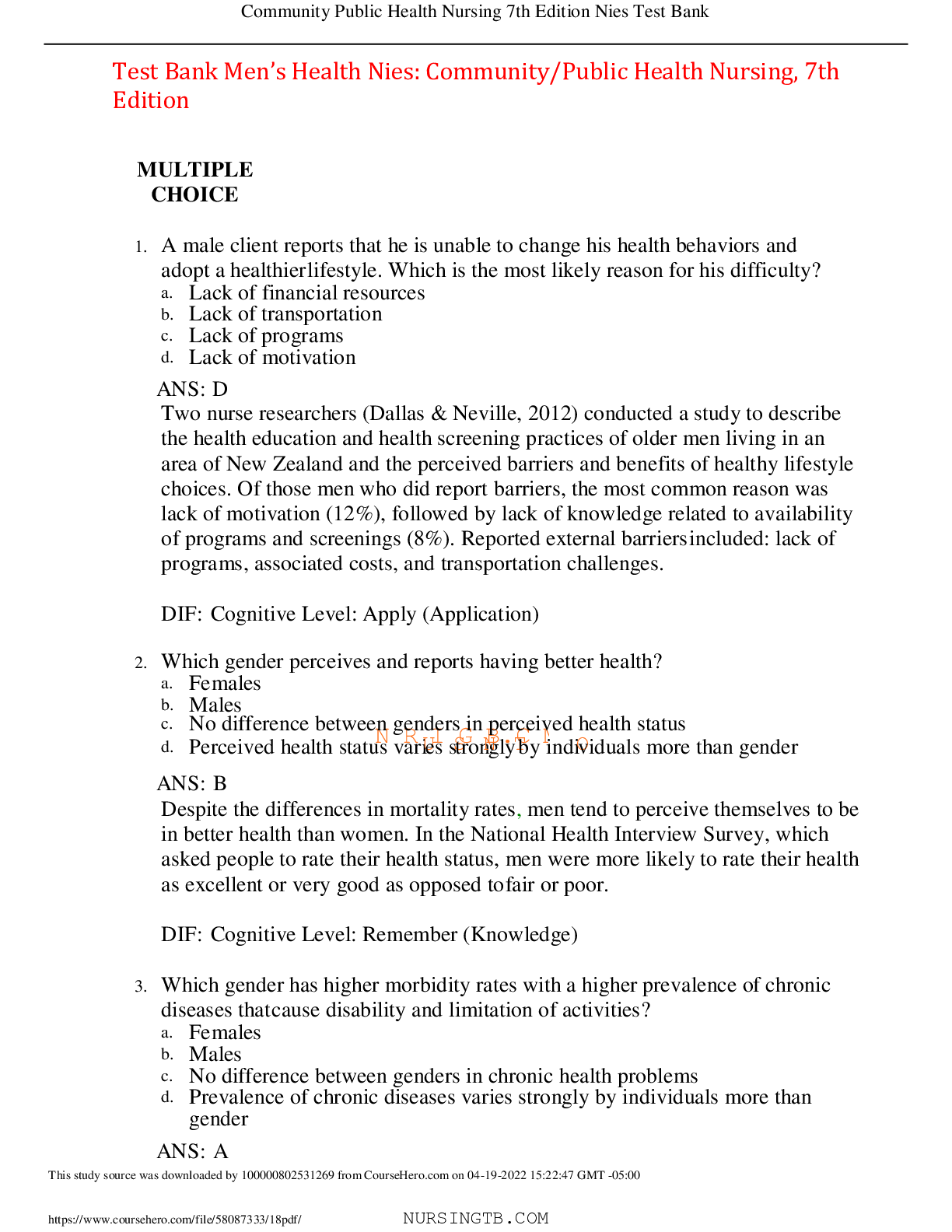
Reviews( 0 )
Document information
Connected school, study & course
About the document
Uploaded On
May 03, 2022
Number of pages
11
Written in
Additional information
This document has been written for:
Uploaded
May 03, 2022
Downloads
0
Views
47




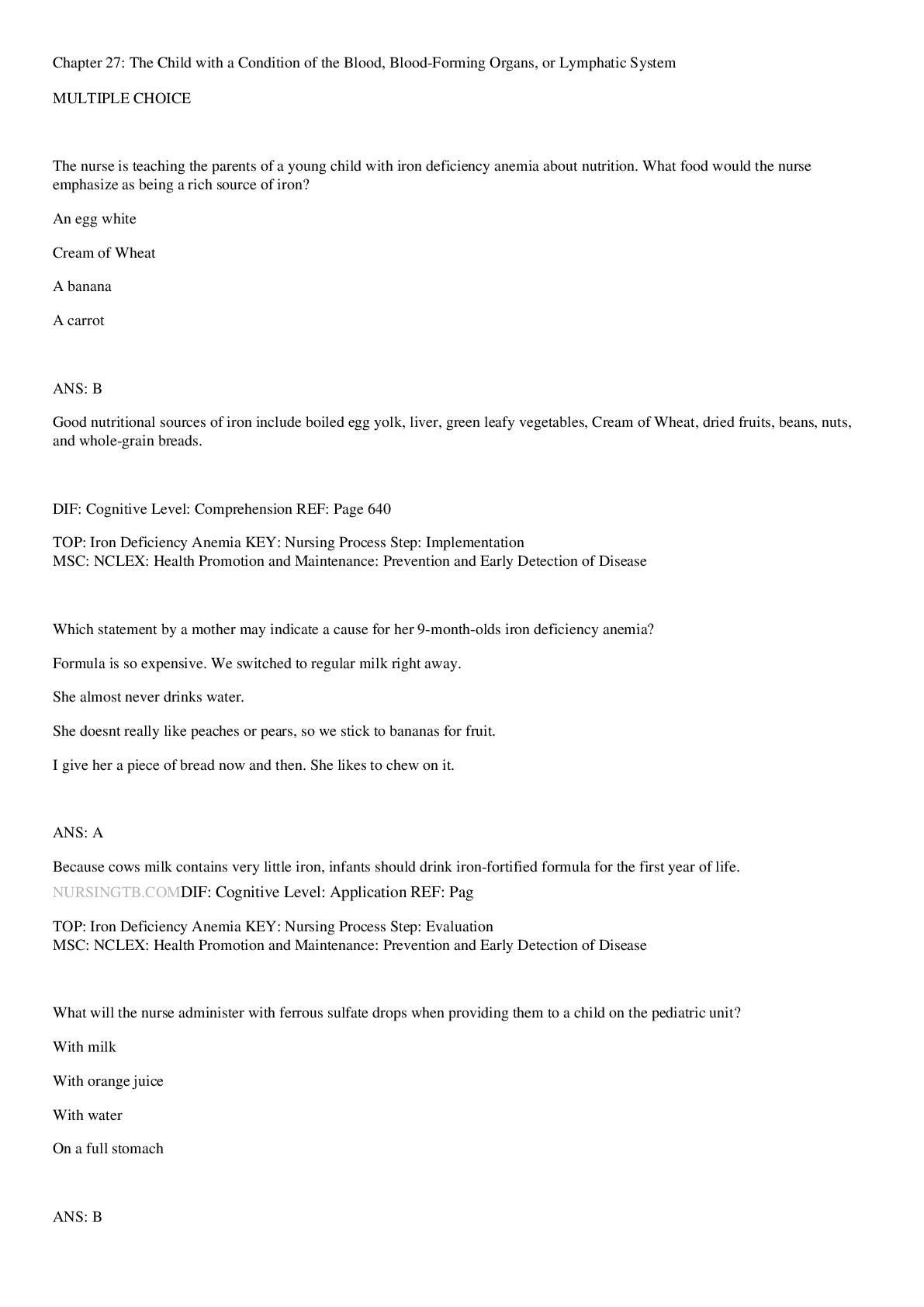




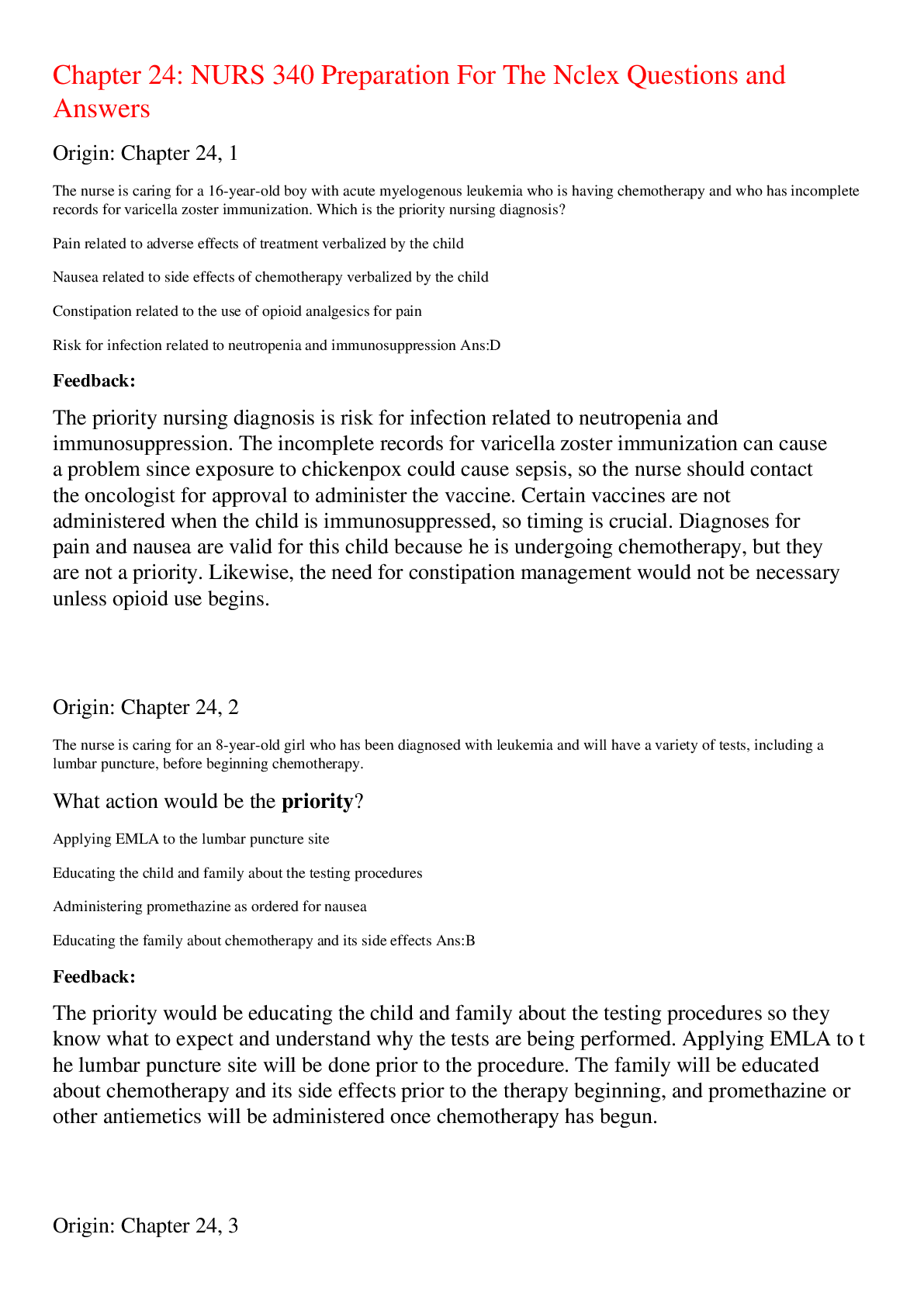
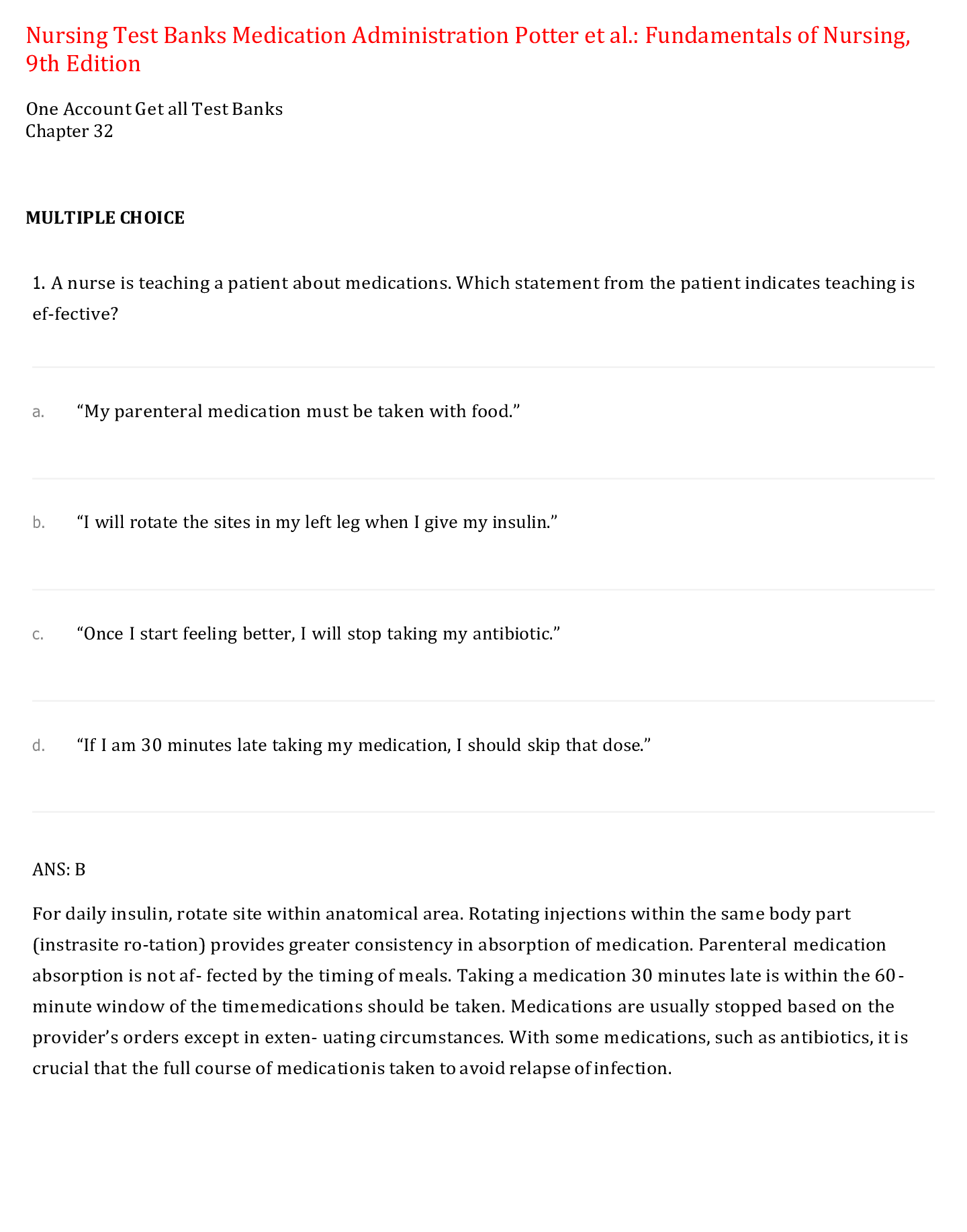

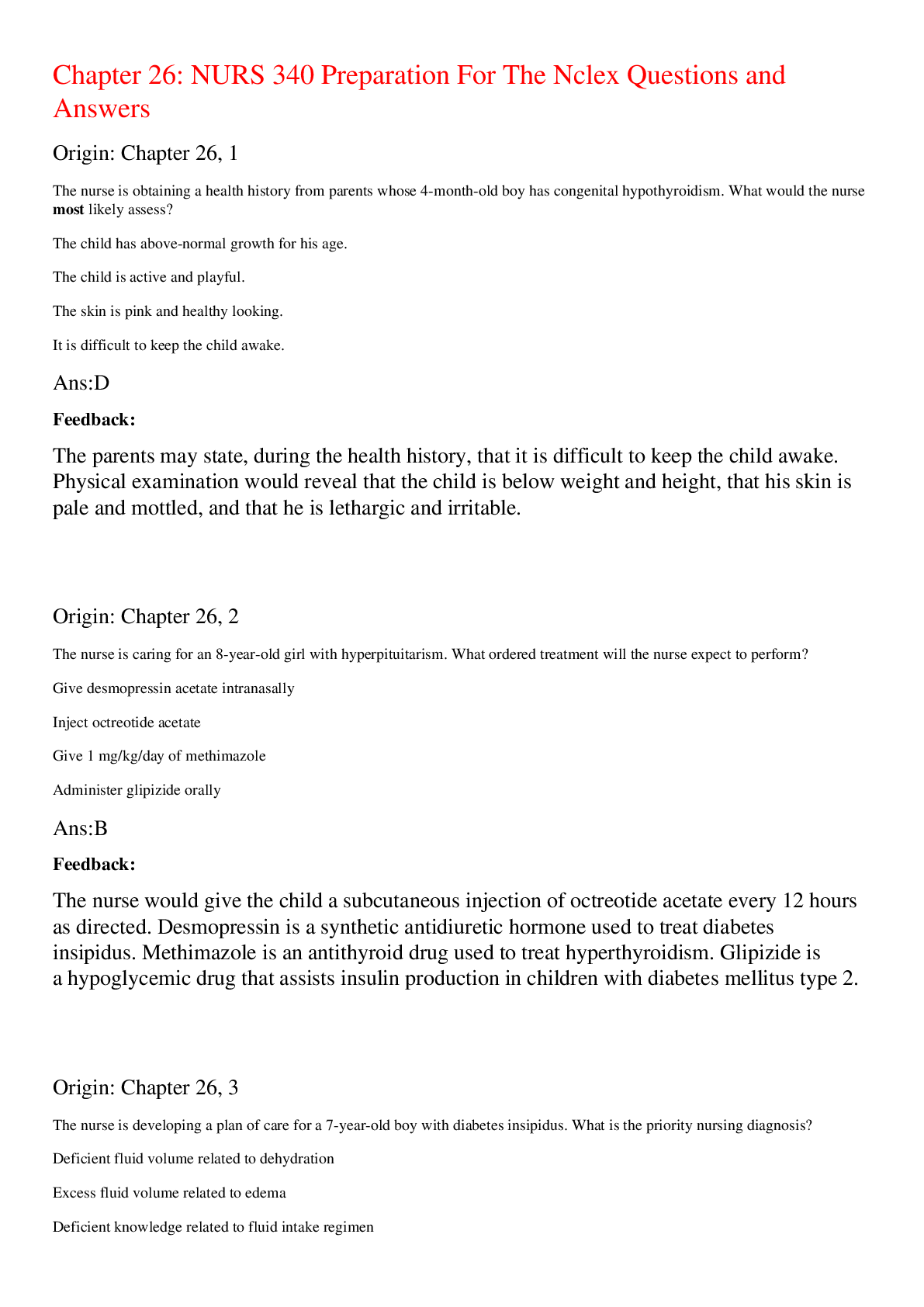
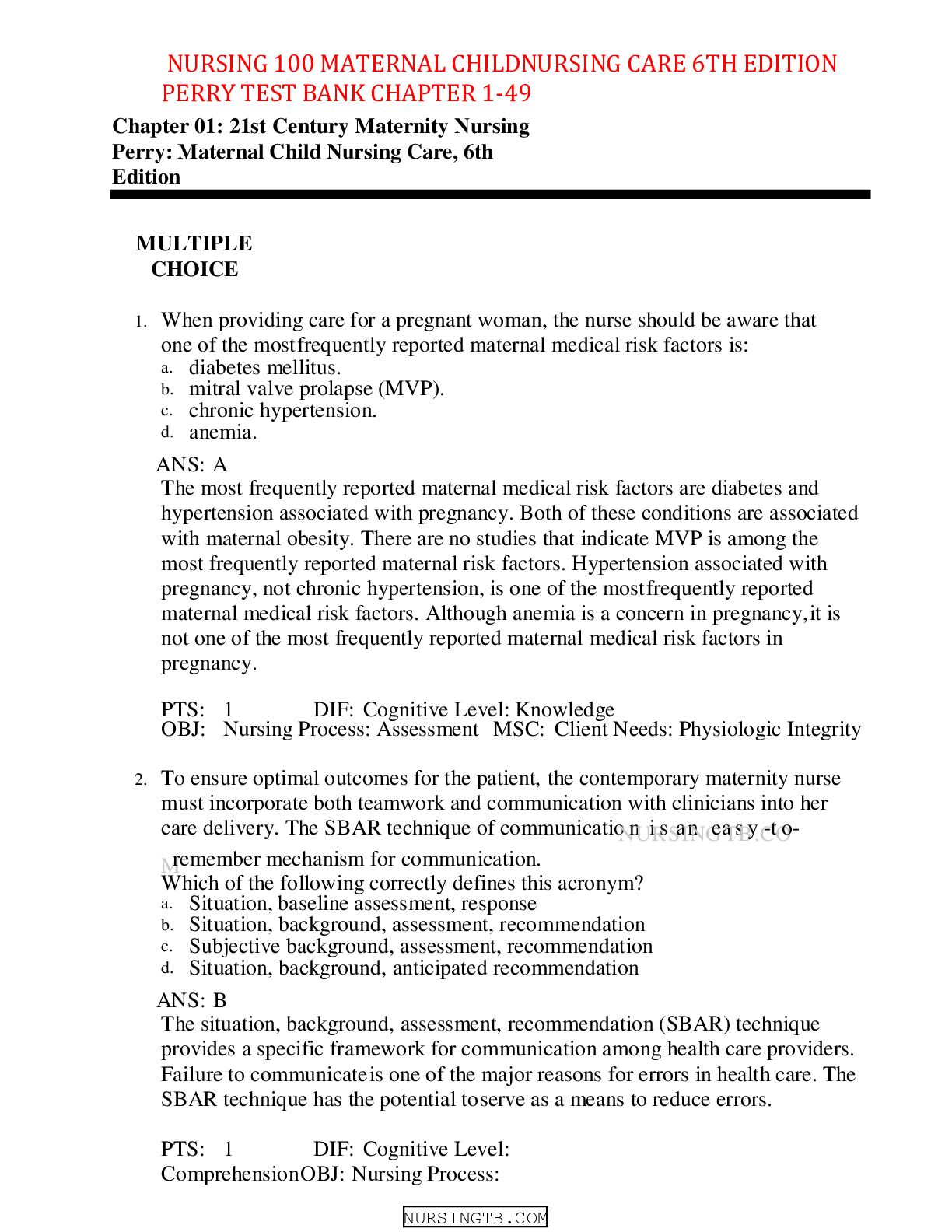

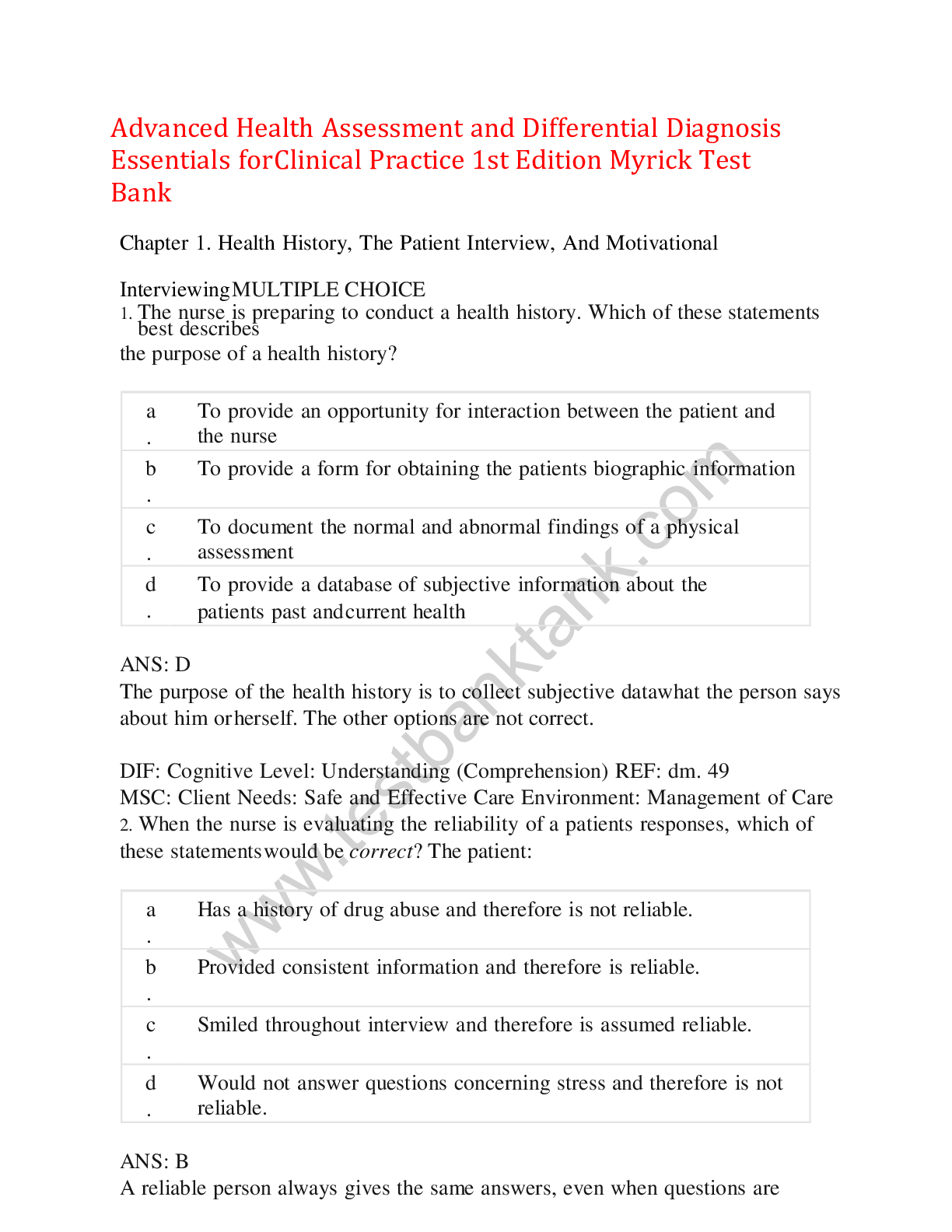

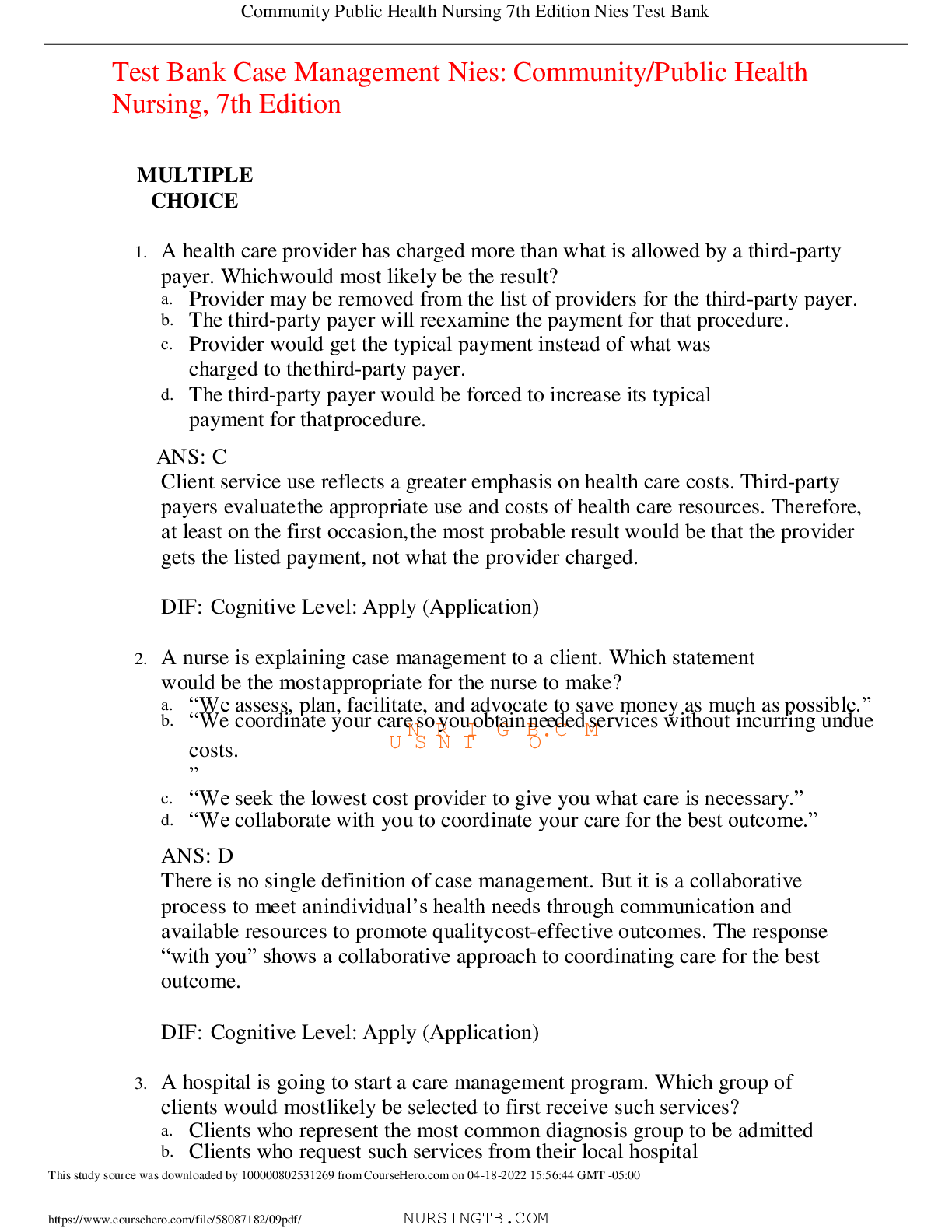
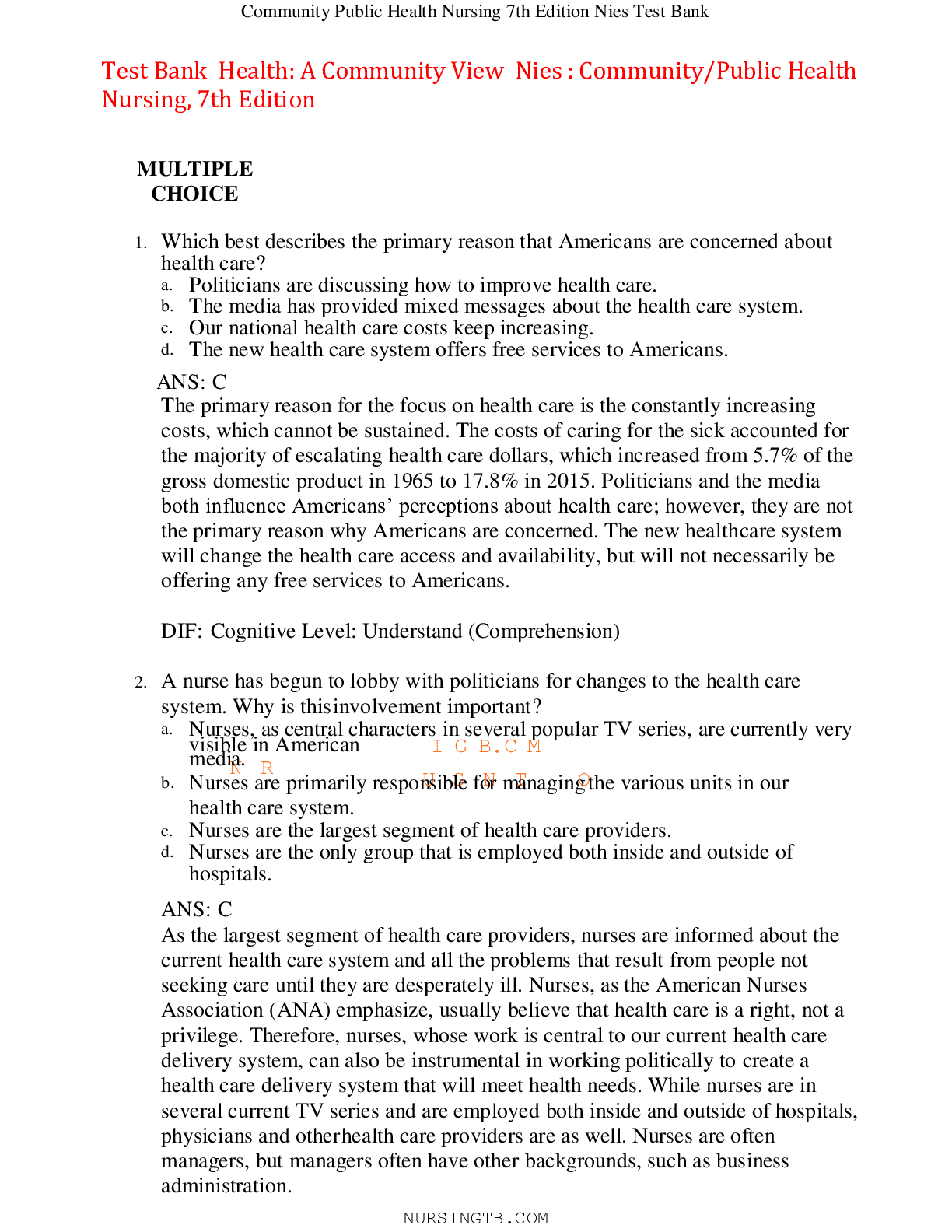
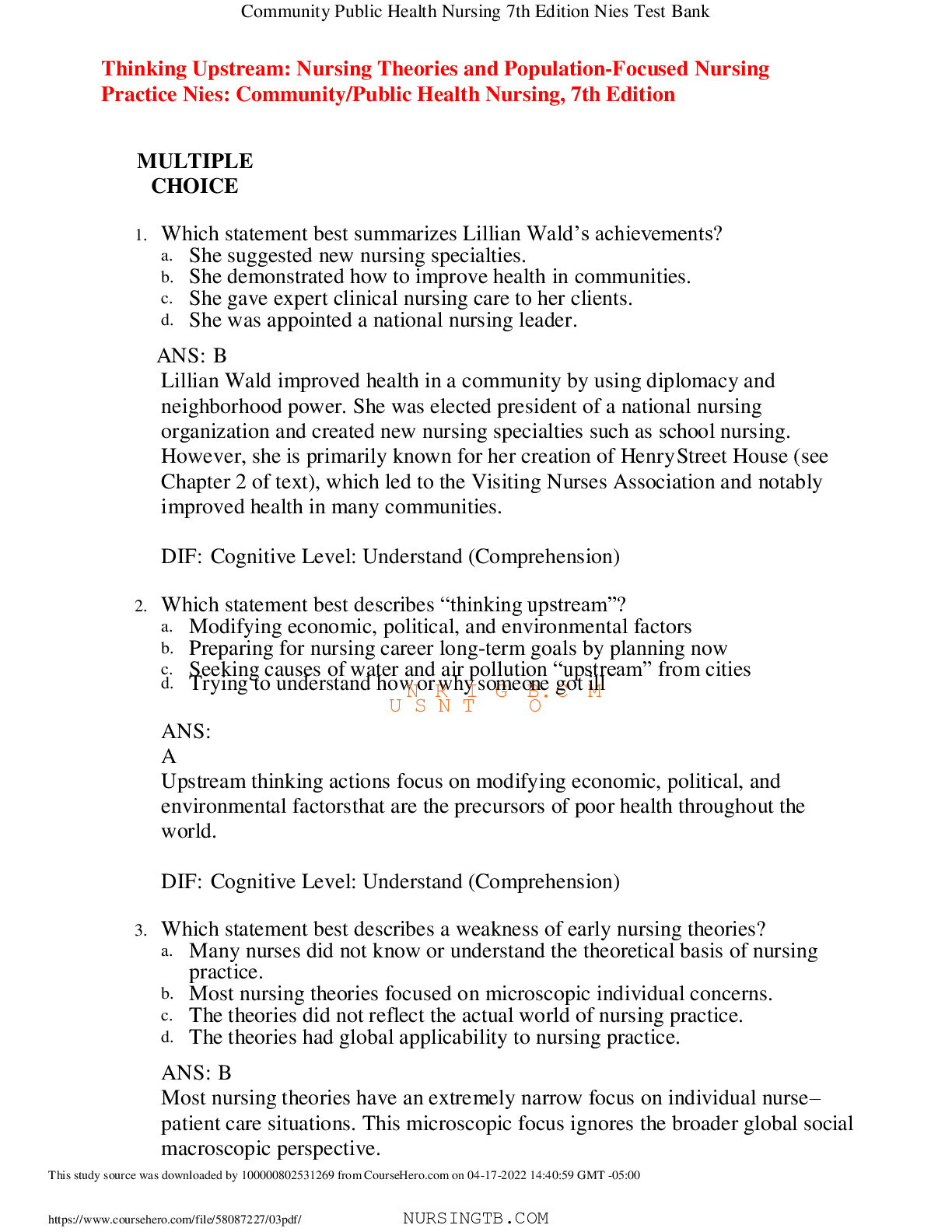

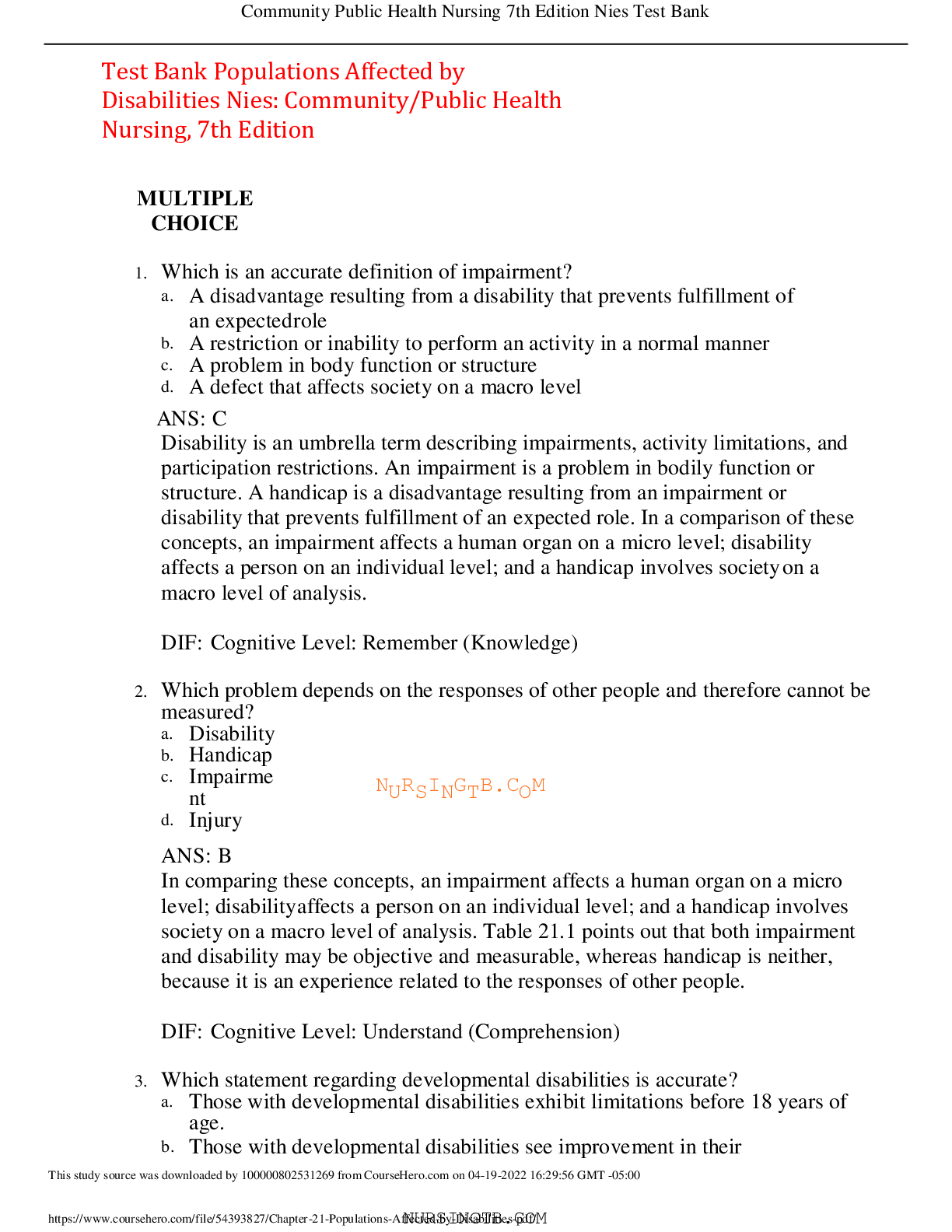


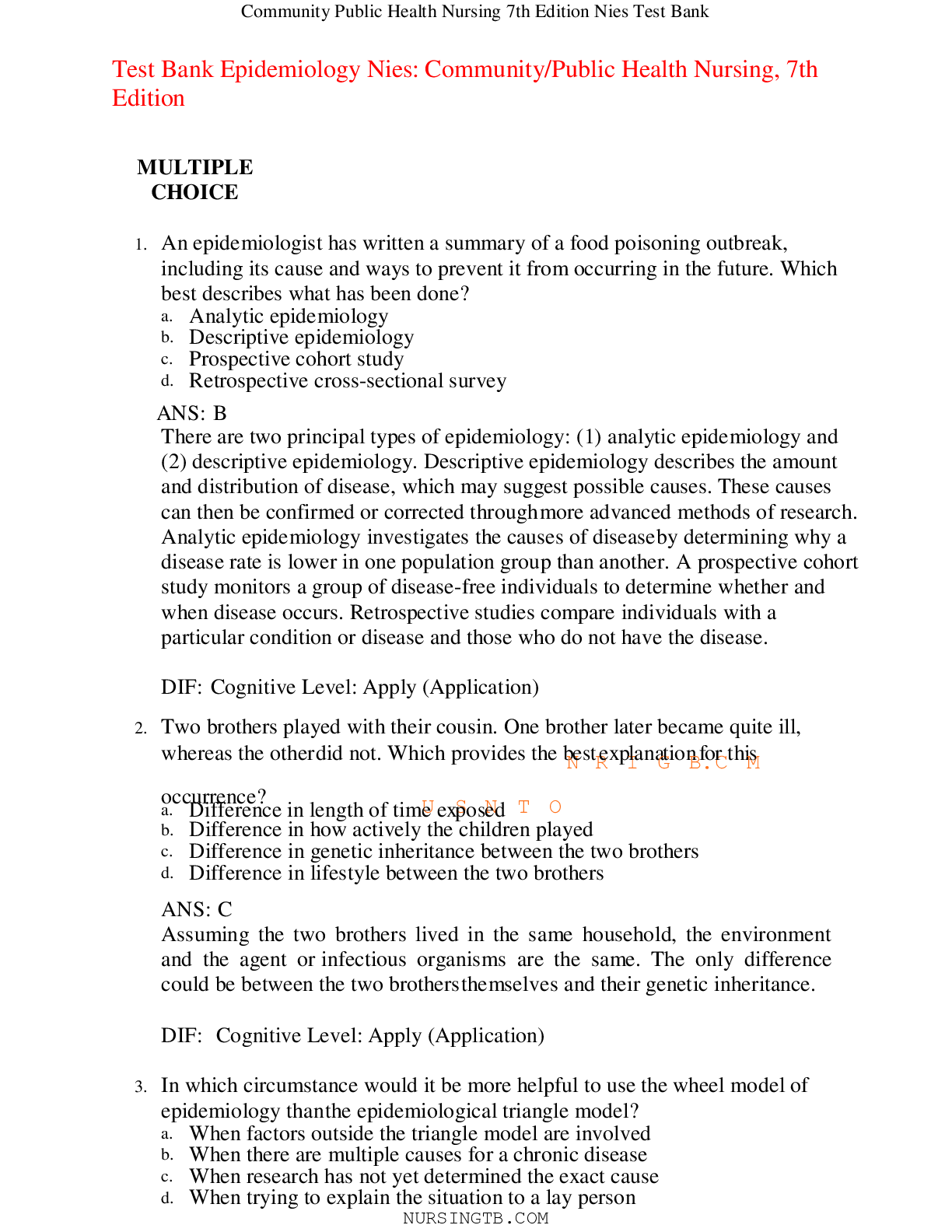
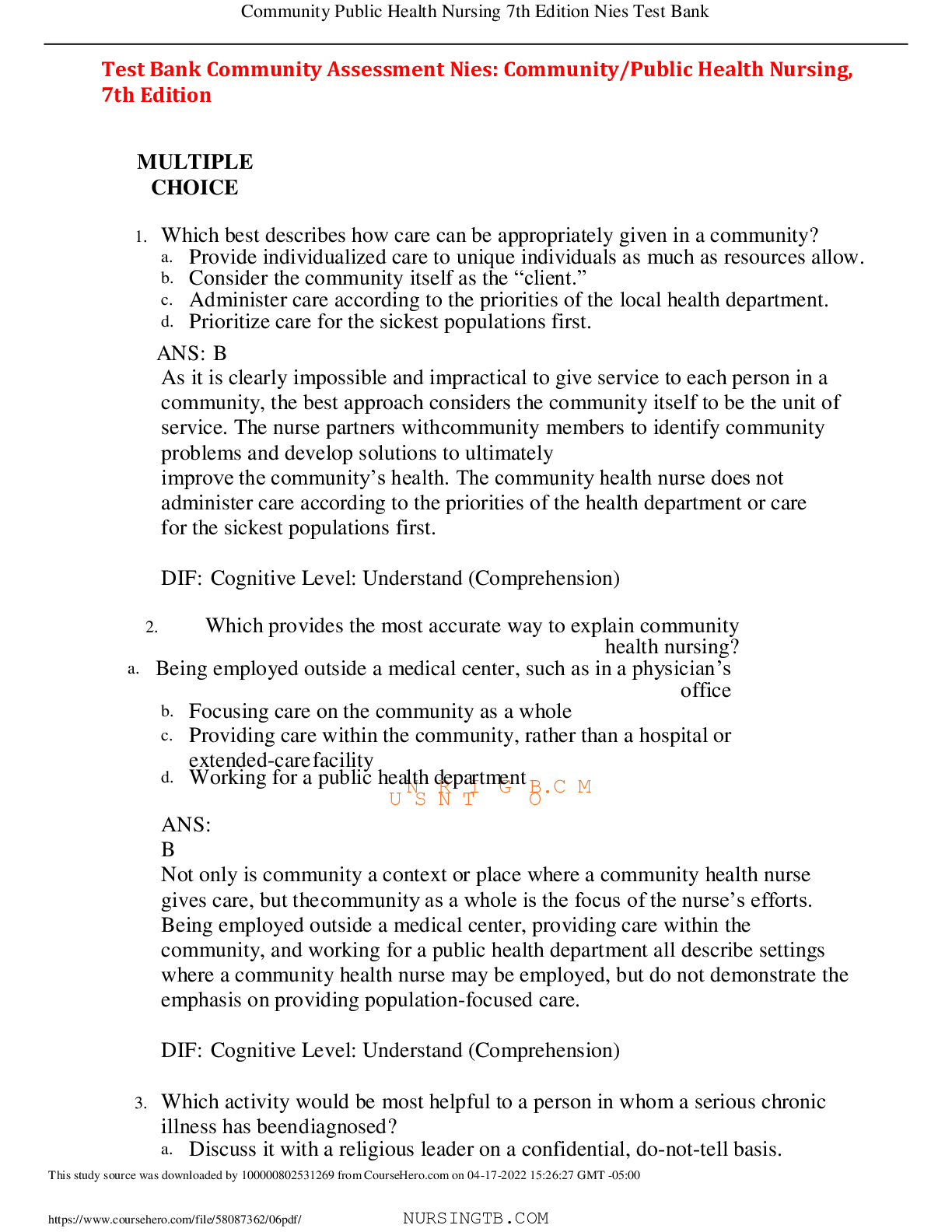


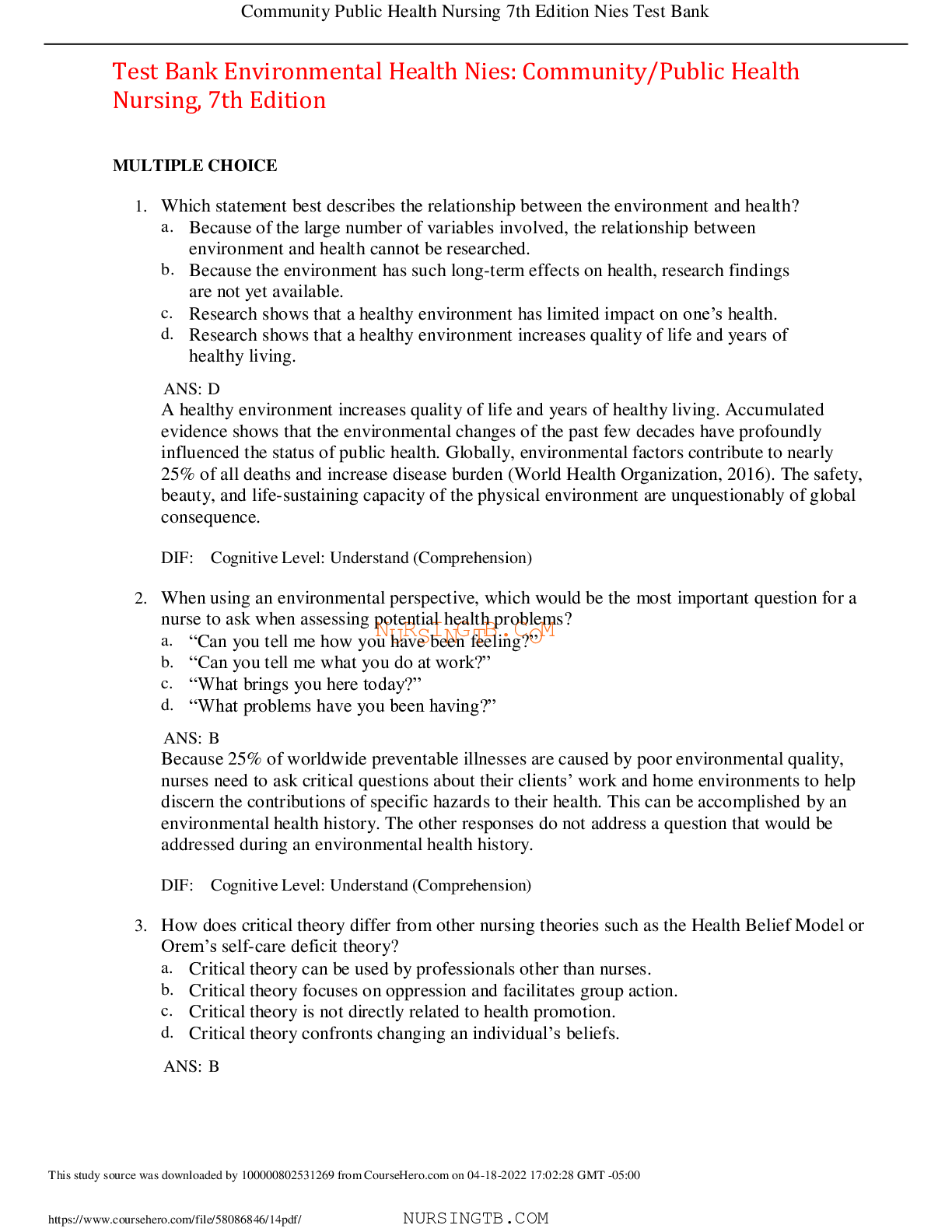
.png)

